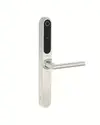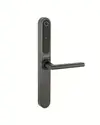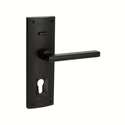Turning Points: The Journey of Door Handles through Time
The humble door handle, often overlooked, has a fascinating and intricate history spanning thousands of years, evolving alongside advancements in architecture, materials, and design aesthetics. From rudimentary wooden latches to precision-engineered modern handles, this essential architectural element has been refined through time.

Ancient Origins

The origins of door handles date back to ancient civilizations. In Ancient Egypt, doors and locks appeared around 5,000 years ago. Early locks were crude wooden devices, with evidence found in Mesopotamia, where pin-tumbler mechanisms prevented entry using wooden bolts. Handles or latches made from wood or leather were primarily functional rather than decorative.
In the Middle Ages, people shifted from shared open spaces to rooms with doors. These wooden doors relied on basic metal latches, hinges, and sometimes early forged handles.
The Rise of Metalworking: 16th–18th Centuries
During the late Renaissance and Baroque periods, advancements in metalworking enabled intricate iron and bronze door handles. By the 17th century, craftsmanship became more ornate, with handles often showcasing elaborate scrollwork and motifs, particularly in Europe.

Industrial Revolution: 19th Century
The Industrial Revolution marked a turning point. Handles transitioned from handmade pieces to mass-produced items. Key milestones included:
- The invention of glass handles (1826-1850), enabled by pressing techniques.
- The rise of cast metal knobs and decorative brass designs, following advancements in casting technology around 1846.
- Patents for door knobs and latches began to emerge in the U.S., reflecting innovation.
By 1876, the Centennial Exposition in the United States introduced decorative hardware, influencing global trends.
20th Century Modernism: Function Meets Form
The 20th century ushered in Modernist design principles, where function met form. Influential figures such as Walter Gropius and Ludwig Wittgenstein contributed to handle design, focusing on simplicity, clean lines, and ergonomic forms. Wittgenstein’s tubular handle design (1927) is still seen as a modern archetype. Similarly, Gropius’s Bauhaus-inspired designs, marked by minimalism and precision, set new standards.
Australia’s architectural evolution also influenced door handle design. In response to its harsh climate, houses like the Queenslander utilized handles suited to airy verandas and functional louvres.

Material Innovations
Materials such as brass, stainless steel, and zinc alloys became dominant in the mid-20th century due to their durability, resistance to corrosion, and ability to accommodate intricate finishes. Modern production processes, including forging, die-casting, and advanced coatings like PVD (Physical Vapor Deposition), revolutionized handle durability and aesthetics.
Glass and ceramic handles enjoyed a resurgence for their decorative appeal, while stainless steel became essential in industrial and hygiene-focused applications due to its resistance to rust.



Modern Day: Our Contribution
Today, companies like Singapore Hardwares Architectural lead the industry with innovative handle designs. Singapore Hardwares emphasizes premium materials, environmentally friendly practices, and industry-leading finishes that align with contemporary and classic architectural styles. Singapore Hardwares collections cater to Australia’s modern housing needs, delivering handles that blend art, security, and functionality.
Our dedication to quality ensures that handles are not only visually appealing but also capable of withstanding Australia’s climate extremes.
Some examples of our lead in advancing the finish, design and technology include the following.
- Singapore Hardwares Durazan finish sets a new benchmark for durability and performance. This high-quality coating is designed to withstand extreme conditions, making it ideal for Australia’s harsh climate. Durazan enhances the longevity of handles, maintaining their beauty and functionality for years to come.
- Micronized Finish
The Micronized finish is an advanced coating that offers superior resistance to wear, tear, and corrosion. Its sleek, refined appearance not only elevates aesthetics but also ensures durability, catering to both residential and commercial applications. - The Stealth
Designed for modern architectural trends, The Stealth represents minimalist elegance. Its clean lines, subtle profile, and ergonomic design make it a perfect choice for contemporary interiors, offering style without compromising function.










- The Knox
The Knox handle combines strength and sophistication. Its bold, robust design makes a statement while delivering exceptional performance, embodying our dedication to both form and function.





- Environmentally Friendly Practices
We remains committed to reducing its environmental footprint by implementing sustainable manufacturing practices. The company prioritizes eco-friendly materials, recyclable packaging, and energy-efficient production processes. This ensures that Singapore hardwares not only enhances interiors but also supports a greener future.
With innovations like Durazan and Micronized finishes, and product designs such as The Stealth and The Knox, We’ve continues to redefine door hardware, offering solutions that are built to amaze while aligning with modern sustainability goals.



Conclusion
From ancient wooden latches to sleek, modern handles engineered with precision, door handles have evolved to reflect cultural, technological, and aesthetic progress. As Singapore Hardwares continues to innovate, the door handle remains an essential yet artistic component of architecture, connecting the user to a building’s form and function.

